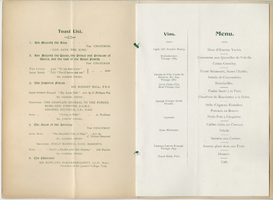Search the Special Collections and Archives Portal
Search Results
International Association of Gaming Attorneys Collection
Identifier
Abstract
The International Association of Gaming Attorneys (IAGA) collection is comprised of materials collected from various corporations and casinos in Nevada and New Jersey, ranging from 1977 to 1986. There are a wide array of documents including: gaming license applications from corporations in Nevada and New Jersey, copies of casino control acts from New Jersey, gaming publications, gaming-conference proceedings, gaming commission reports, newsletters and correspondence of the National Association of Gaming Attorneys (NAGA).
Archival Collection
Nancy Ellen Webb Williams Papers
Identifier
Abstract
The Nancy Ellen Webb Williams Papers (1983 to 1996) are related to William's career as a writer. The papers include newspaper clippings, photos, fliers, and correspondence. Also included is one of Williams' books of poetry, "The Soul Side: Big Mama Remembers."
Archival Collection
Joseph "Wingy" Manone Papers
Identifier
Abstract
The Joseph "Wingy" Manone Papers (1934-1996) include a partial draft of his autobiography, newspaper clippings, correspondence, magazine articles, and press releases related to his musical career. Manone also wrote music, some of which is included in the collection.
Archival Collection
John Ponticello Papers
Identifier
Abstract
The John Ponticello Papers are comprised of materials related to Ponticello's experiences in Las Vegas, Nevada between 1956 and 1971 with an emphasis on his Research Gambling Game Project, which he conducted and published between 1968 and 1971. The collection includes materials regarding gaming licenses and applications, research agreements, descriptions of the project, and publications about the research project. Also included are materials from Ponticello's experiences in Las Vegas such as business cards, county work cards, and souvenir photographs.
Archival Collection
Ann Brewington Papers
Identifier
Abstract
Ann Brewington Papers (1984-1987) consist of letters and clippings related to Nevada history. Correspondence is primarily from Anne Brewington's sister, Ida Brewington, to Brewington regarding Ida Pittman's death. This collection also contains a letter from Florence Cahlan and copies of letters sent to Cahlan about an article she had written on Ida Brewington Pittman. Also included is another article about Pittman that appeared in the December 2, 1984 Nevadan that has a few hand written notes in the margins, as do a few of the letters.
Archival Collection
John Janney Photograph Collection on Pioche, Nevada
Identifier
Abstract
The John Janney Photograph Collection on Pioche, Nevada contains photographs of mining operations and townspeople in Pioche, Nevada from 1908 to 1934. The photographs are primarily panoramic views of the town, mines, and landscape around Pioche, where Janney was president of Pioche Mines Consolidated until his death in 1967. The photographs also depict the baseball field in Pioche, a train crossing the desert in Lincoln County, and the Lee Family.
Archival Collection
Hank Harrison Photograph Collection on Helldorado Days
Identifier
Abstract
The Hank Harrison Photograph Collection on Helldorado Days contains two black-and-white photographs of the Helldorado Days festival in Las Vegas, Nevada from approximately 1940 to 1977. The first photograph depicts a rodeo clown distracting a bull; the second photograph is of Ned Romero, an actor in Helldorado.
Archival Collection
Las Vegas Archive Memorabilia and Promotional Materials
Identifier
Abstract
The Las Vegas Archive Memorabilia and Promotional Materials (approximately 1960-2019) contains reproductions of photographs taken of historic landmarks around Las Vegas, Nevada and entertainers like Elvis Presley, Nat King Cole, Frank Sinatra, Dean Martin, and Liberace performing in Las Vegas. The collection also contains digital photographs from 2008 of an airship displaying an advertisement for the M Resort Spa and Casino. There is also memorabilia from the MGM Grand Hotel including a gaming guide, decks of playing cards, and a commemorative drinking glass. The collection also includes several historic postcards depicting Las Vegas, political campaign buttons for local Nevada elections, and greeting cards from U.S. Representative Jim Santini.
Archival Collection
Irma McGonagill Photograph Collection
Identifier
Abstract
The Irma McGonagill Photograph Collection (1870-1925) consists of thirty black-and-white photographic prints, ten postcards, and fourteen photographic negatives showing Irma McGonagill and her family in Tonopah, Nevada during the mining boom. The images depict the town of Tonopah, mines around the Tonopah area, homes in Tonopah, and the McGonagill family.
Archival Collection

